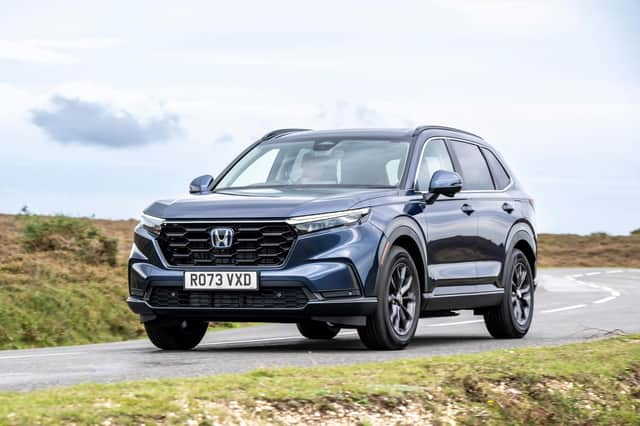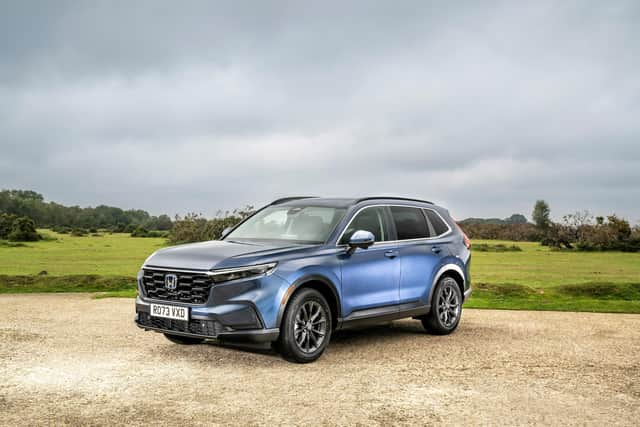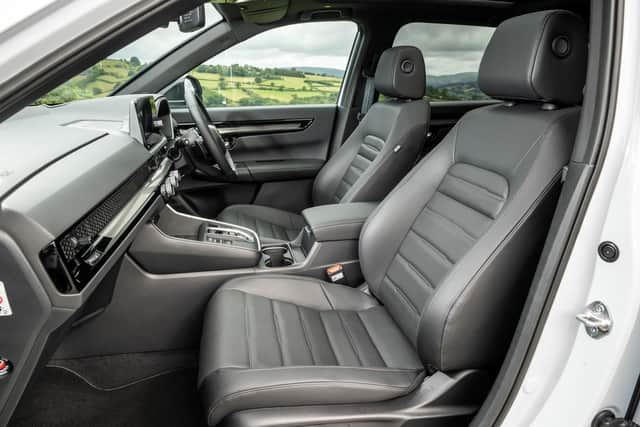Review: Honda CR-V e:HEV


As the debates rumble on about the practicality of all-electric cars, their woefully inadequate ranges and the availability of charging ports, hybrid cars make far more sense in just about every way.
Take the Honda CR-V, for example, the Japanese company’s flagship SUV which entered its sixth generation in 2023.
Advertisement
Hide AdAdvertisement
Hide AdIt is available in two versions, both powered by the same two-litre four cylinder engine and electric motor together delivering 181bhp. The difference between the two is in the battery and the way it is charged.


The e:PHEV front-wheel drive plug-in hybrid gets a bigger battery than the e:HEV and can travel up to 50 miles in all-electric mode only - a real bonus if you only have a short commute and available charging facilities at both ends of your journey.
The e:HEV, as tested here, is an all-wheel drive, full hybrid and is self-charging so there is no need to plug in: it draws power from regenerative braking. The benefits are self-evident, no need for a charging port and a combined range of around 596 miles.
There are three driving modes Normal, Sport and Econ.
Acceleration from 0-62mph is an impressive 9.5 seconds going on to a top speed of116mph. The engine is super quiet even under fierce acceleration which is smooth and controlled with the CVT automatic transmission gliding through the gears seamlessly.


Advertisement
Hide AdAdvertisement
Hide AdAlthough performance has been increased compared to the previous model, emissions have reduced to 151g/km and fuel consumption is now officially 42.8mpg.
Changes for the 2023 model include a more sophisticated raft of driver and connectivity aids, higher-end materials throughout the cabin and Honda’s Sensing 360 which alerts the driver to potential collisions in all directions - a step towards Honda’s global aim of zero road fatalities involving its vehicles. There are 11 airbags in this new model.
Although the design cues of the new CR-V are broadly similar to the previous model, the front end of both options have a more aggressive look with an updated LED light cluster at the rear.
It’s also longer and wider which translates to loads of legroom for rear seat passengers (16mm more) and 579 litres of boot space with all seats in place and a maximum floor to roof capacity of 1643 litres.
Advertisement
Hide AdAdvertisement
Hide AdThe rear seats slide forward by up to 190mm to make the boot even more practical. The electric tailgate seems more responsive than others I’ve used and the hands free operation worked every time.
Cabin controls are easy to navigate with the most often used physical buttons rather than menu options.
The dash has a centrally mounted nine-inch infotainment screen which is clear but it could have been angled towards the driver a touch.
There’s plenty of storage space with a useful cubby hole between the seats which adjusts electronically.
Advertisement
Hide AdAdvertisement
Hide AdFront seats are heated and as our test was during a particularly cold spell it was most welcome, as was the heated steering wheel.
Head-up display is a feature of more and more cars and one I welcome - the less time with the driver’s eyes away from the road the better.
Specifications
Honda CR-V e:HEV
Price: £48,995 (£49,670 as tested)
Engine: Two-litre hybrid petrol
Power: 181bhp
Torque: 139lb/ft
Transmission: CVT automatic
Top speed: 116mph
0-62mph: 9.5 seconds
Economy: 42.8mpg
CO 2 emissions:151g/km